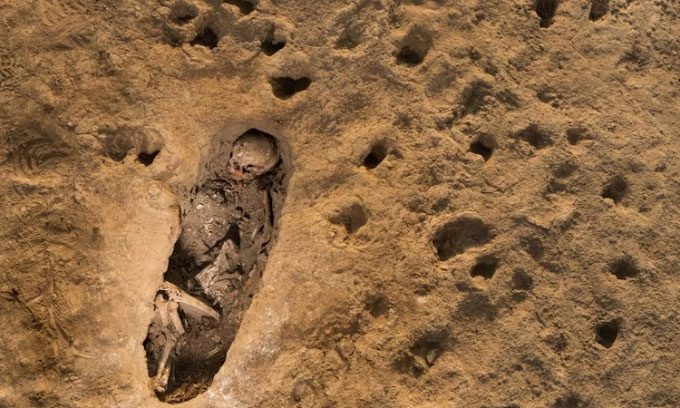Researchers Discover Chimu People Sacrificed Hundreds of Children to Appeal to Deities Against Heavy Rains Caused by El Niño Phenomenon.
While many scientists believe that the impacts of the El Niño cycle are intensifying due to climate change, archaeological evidence shows that this phenomenon has severely affected life in Peru for over 1,000 years. Past communities struggled to cope with its effects through practical techniques on the ground and by spiritually appealing to the gods, specifically by conducting large-scale child sacrifices never before seen in world history, according to National Geographic.

Child remains in a grave at Chan Chan. (Photo: National Geographic)
Since 2011, Peruvian archaeologist Gabriel Prieto has found evidence of mass child sacrifice around Chan Chan, a city built from adobe bricks in northern Peru that served as the capital of the Chimu from the 11th century until their conquest by the Incas in 1470. To date, the research team has discovered over 250 young victims who died around 1400 – 1450. Most were dealt a swift blow to the chest and buried with simple shrouds alongside young llamas.
The majority of sacrificed Chimu children were excavated from archaeological sites along the Peruvian coast, where clear evidence of El Niño events has been preserved. This includes a thick layer of ancient dry mud that entombed the victims, indicating the area once experienced heavy rainfall. In the arid coastal region of northern Peru, such rainfall is always associated with El Niño, Prieto explains.
The inhabitants of Chan Chan relied on a carefully managed irrigation system and fishing along the coast, both of which were disrupted by high sea temperatures and heavy rains linked to this recurring climate phenomenon. According to the research team’s hypothesis, severe El Niño events could undermine the economic and political stability of the Chimu kingdom. Priests and rulers might have ordered collective sacrifices in an effort to beseech the deities to halt the heavy rains. Jane Eva Baxter, an anthropology professor at DePaul University who specializes in the history of children and childhood, emphasizes that the Chimu may have viewed children as the most valuable offerings they could present to the gods.
The urgency to appease the spirits and prevent heavy rains from El Niño could have been a pressing issue for the Chimu community, yet the mass sacrifices appear to have been meticulously organized. Hundreds of healthy boys and girls were brought in from various regions across the kingdom for the sacrifices. Young one-humped llamas from the royal herds were also selected for the event based on their age and coat color.
At the Huanchaquito-Las Llamas site, Prieto and his colleague John Verano, a biological anthropologist at Tulane University, excavated most of the young victims’ remains between 2011 and 2018. Signs and forensic evidence helped them reconstruct the sequence of events. Footprints and traces in the dry mud revealed a procession to the sacrificial site. Small bare footprints alongside traces of four-legged animals led Prieto and Verano to believe that the victims were still alive when they reached the burial site and were killed there. The absence of insect remains indicates that the children were carefully wrapped in shrouds and buried with llamas.
The research team could not determine whether the sacrificial practices helped mitigate the flooding rains, but the event sheds light on the desperate final years of the declining kingdom. As archaeologists continue to work around the Chan Chan World Heritage site, they may uncover more evidence of efforts to cope with the devastating impacts of the El Niño phenomenon.


















































